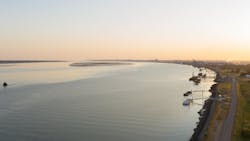Lhyfe, Nantes - Saint Nazaire Port collaborate to develop offshore renewable hydrogen
Offshore staff
NANTES AND SAINT-NAZAIRE, France — Lhyfe, a producer of green renewable hydrogen, and Nantes - Saint Nazaire Port, France’s fourth largest seaport, have reached a partnership agreement to develop the offshore renewable sector and ramp up the energy transition on the Loire Estuary.
At the end of September in the Saint Nazaire dock basins, Lhyfe launched its Sealhyfe project to deliver the world’s first offshore renewable hydrogen production prototype, which will have a capacity of 1 MW and will be connected to a floating wind turbine.
Lhyfe already operates a renewable hydrogen production facility employing water electrolysis and is planning to set up similar onshore facilities throughout Europe. The company is considering the idea of developing and operating offshore renewable hydrogen production platforms on existing fixed structures or on fixed-position or floating foundations, and it is ramping up its R&D investments for the development of offshore renewable hydrogen production as close as possible to offshore energy sources.
By 2030-2035, the offshore sector could represent additional installed capacity of the order of 3 GW for Lhyfe.
The Nantes ‒ Saint Nazaire Port Authority is studying the possible deployment scenarios for the hydrogen sector within its port ecosystem, with the ambition of making Nantes ‒ Saint Nazaire the first major port facility for hydrogen on France’s Atlantic Seaboard.
Nantes ‒ Saint Nazaire Port and Lhyfe will work together to identify, understand and assess the conditions for the establishment of a supply chain associated with offshore hydrogen production.
This collaboration is intended to identify the port areas and facilities capable of accommodating R&D prototypes and being utilized to try out innovative solutions. The partnership also focusses on the identification of the industrial requirements involved in the construction of the equipment to be used to produce offshore hydrogen on a mass scale, and on the port infrastructures necessary for the production, launching and integration of those future items of equipment. Lastly, the two parties will deliberate together on how best to bring ashore the renewable hydrogen mass-produced at sea, so as to define the requisite industrial and logistical requirements for the reception and injection of the gas into the land-based network.
11.21.2022
